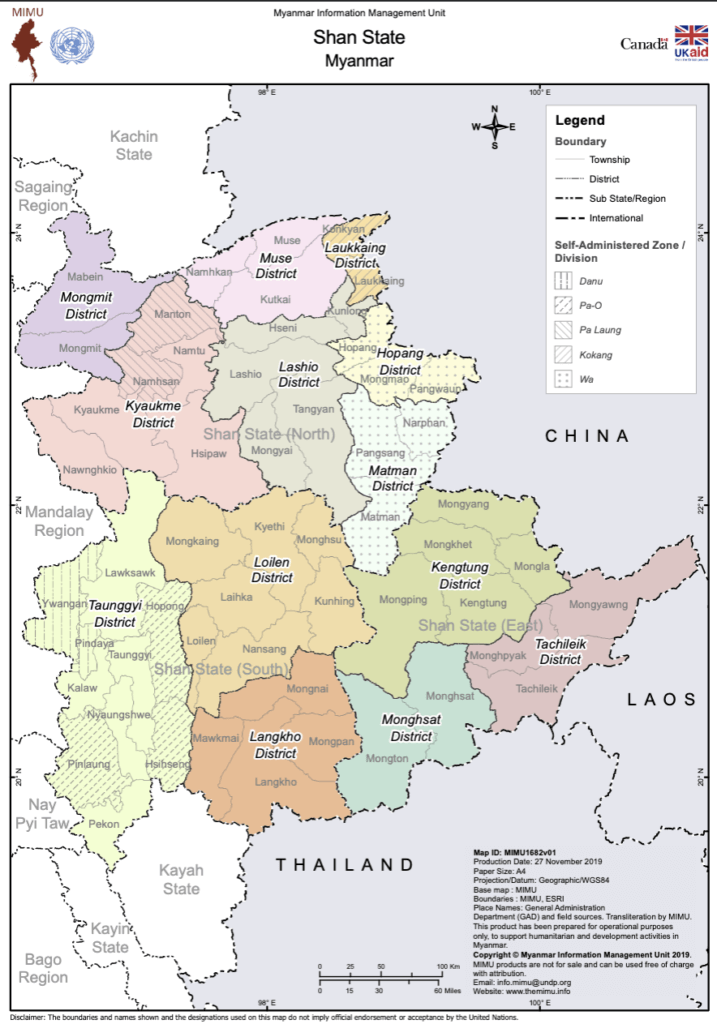Shan State is a state of Myanmar. Shan State borders China to the north, Laos to the east, and Thailand to the south, and five administrative divisions of Burma in the west. Largest of the 14 administrative divisions by land area, Shan State covers 155,800 km2, almost a quarter of the total area of Burma. The state gets its name from Burmese name for the Tai people: “Shan people”. The Shan constitute the majority among several ethnic groups that inhabit the area. Shan is largely rural, with only three cities of significant size: Lashio, Kengtung, and the capital, Taunggyi. Taunggyi is 150.7 km northeast of the nation’s capital Naypyitaw.Shan State, with many ethnic groups, is home to several armed ethnic armies. While the military government has signed ceasefire agreements with most groups, vast areas of the state, especially those east of the Salween River, remain outside the central government’s control, and in recent years have come under heavy ethnic-Han-Chinese economic and political influence. Other areas are under the control of military groups such as the Shan State Army.
Shan State is the unitary successor state to the Burmese Shan States, the princely states that were under some degree of control of the Irrawaddy valley-based Burmese kingdoms.Historical Tai-Shan states extended well beyond the Burmese Shan States, ranging from full-fledged kingdoms of Assam in the northwest to Lan Xang in the east, to Lan Na and Ayutthaya in the southeast, as well as several petty princely states in between, covering present-day northern Chin State, northern Sagaing Division, Kachin State, Kayah State in Myanmar as well as Laos, Thailand and the southwestern part of Yunnan, China. The definition of Burmese Shan States does not include the Ava Kingdom and the Hanthawaddy Kingdom of the 13th to 16th centuries, although the founders of these kingdoms were Burmanized Shans and Monized Shans, respectively.
The founding of Shan states inside the present-day boundaries of Burma began during the Pagan Kingdom in the Shan Hills and accelerated after 1287, when the Pagan Kingdom fell to the Mongols. The Shans, who came south with the Mongols, stayed, and quickly came to dominate much of northern to the eastern arc of Burma—from northwestern Sagaing Division to Kachin Hills to the present-day Shan Hills. The most powerful Shan states were Mong Yang (Mohnyin) and Mong Kawng (Mogaung) in present-day Kachin State, followed by Hsenwi (Theinni), Hsipaw (Thibaw) and Mong Mit (Momeik) in present-day northern Shan State. Smaller Shan states, such as Kale in northwestern Sagaing Division, Bhamo in Kachin State, Yawnghwe (Nyaungshwe) and Kengtung (Kyaingtong) in Shan State, and Mong Pai (Mobye) in Kayah State, played a precarious game of paying allegiance to more powerful states, sometimes simultaneously.
The newly founded Shan States were multi-ethnic, and included other ethnic minorities such as the Chin, the Kachin, the Wa, the Ta’ang, the Lisu, the Lahu, the Pa O, and the Kayah. Although Burmanised Shans founded the Ava Kingdom that ruled central Burma, other Shan states, Mohnyin in particular, constantly raided Ava territories throughout the years. A Mohnyin-led Confederation of Shan States finally conquered Ava in 1527.



